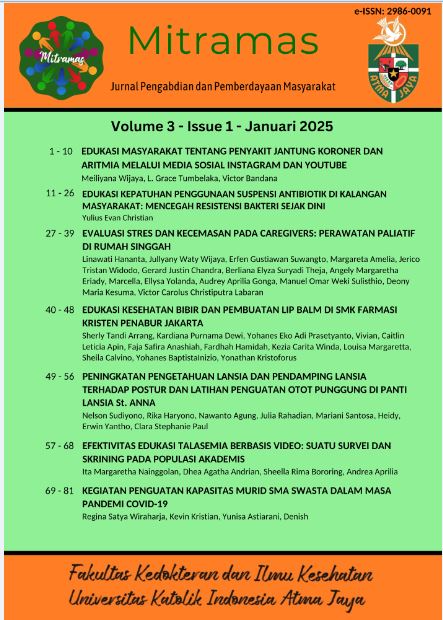EVALUASI STRES DAN KECEMASAN PADA CAREGIVERS: PERAWATAN PALIATIF DI RUMAH SINGGAH
DOI:
https://doi.org/10.25170/mitramas.v3i1.6042Keywords:
Stres, Kecemasan, Paliatif, Perceived Stress Scale, Generalized Anxiety Disorder-7Abstract
Perawatan paliatif merupakan elemen penting dalam memberikan perawatan berkualitas tinggi bagi pasien dengan penyakit kronis atau serius. Penyakit serius berhubungan dengan risiko kematian yang tinggi dan memberikan dampak besar pada aspek fisik, psikologis, maupun spiritualitas pasien, caregiver, ataupun keluarga. Peran caregiver dalam perawatan pasien dengan penyakit terminal atau serius sering kali membawa beban emosional dan fisik yang berat, yang dapat menimbulkan kecemasan dan stres. Perawatan paliatif berperan dalam mengelola gejala serta memenuhi kebutuhan pasien dan keluarga, yang pada akhirnya meningkatkan kualitas hidup pasien, caregiver, maupun keluarga. Kegiatan pengabdian masyarakat (abdimas) ini dilaksanakan di lima rumah singgah di Jakarta (RHI, WNH, CISC1, CISC2, dan RSL), dengan melakukan terapi seni yaitu inkblot dan mengevaluasi menggunakan kuesioner Perceived Stress Scale (PSS) untuk menilai tingkat stres dan kuesioner Generalized Anxiety Disorder-7 (GAD) untuk menilai tingkat kecemasan caregiver. Hasil asesmen menunjukkan bahwa sebagian besar caregiver mengalami tingkat kecemasan rendah (44,8%) hingga sedang (20,7%) dan memiliki tingkat stres ringan (41,4%) hingga sedang (51,7%). Dukungan sosial, spiritual, dan religius sangat penting, disertai dengan beberapa teknik relaksasi seperti meditasi, yoga, dan olahraga sehingga membantu mengurangi stres dan kecemasan.
References
Alcalde, J., & Zimmermann, C. (2022, April 28). Stigma about palliative care: Origins and solutions. https://doi.org/10.3332/ecancer.2022.1377
Bhatnagar, M., Kempfer, L. A., & Lagnese, K. R. (2024). Hospice Care. In StatPearls. StatPearls Publishing. http://www.ncbi.nlm.nih.gov/books/NBK537296/
BMC Public Health. 2019. Psychometric properties of the perceived stress scale in Ethiopian university students Full Text. (n.d.). Retrieved September 3, 2024, from https://bmcpublichealth.biomedcentral.com/articles/10.1186/s12889-018-6310-z
Broxson, J., & Feliciano, L. (2020). Understanding the Impacts of Caregiver Stress. Professional Case Management, 25(4), 213–219. https://doi.org/10.1097/NCM.0000000000000414
Falzarano, F. B., Cimarolli, V., Boerner, K., Siedlecki, K. L., & Horowitz, A. (2022). Use of Home Care Services Reduces Care-Related Strain in Long-Distance Caregivers. The Gerontologist, 62(2), 252–261. https://doi.org/10.1093/geront/gnab088
Karimi Moghaddam, Z., Rostami, M., Zeraatchi, A., Mohammadi Bytamar, J., Saed, O., & Zenozian, S. (2023). Caregiving burden, depression, and anxiety among family caregivers of patients with cancer: An investigation of patient and caregiver factors. Frontiers in Psychology, 14, 1059605. https://doi.org/10.3389/fpsyg.2023.1059605
Kementrian Kesehatan Republik Indonesia. (2020). Apakah yang dimaksud Stres itu? - Penyakit Tidak Menular Indonesia. (n.d.). Retrieved September 3, 2024, from https://p2ptm.kemkes.go.id/infographic-p2ptm/stress/apakah-yang-dimaksud-stres-itu
Loo, Y. X., Yan, S., & Low, L. L. (2022). Caregiver burden and its prevalence, measurement scales, predictive factors and impact: A review with an Asian perspective. Singapore Medical Journal, 63(10), 593–603. https://doi.org/10.11622/smedj.2021033
Moss, K. O., Kurzawa, C., Daly, B., & Prince-Paul, M. (2019). Identifying and Addressing Family Caregiver Anxiety. Journal of hospice and palliative nursing : JHPN : the official journal of the Hospice and Palliative Nurses Association, 21(1), 14–20. https://doi.org/10.1097/NJH.0000000000000489
Myint, A. T., Tiraphat, S., Jayasvasti, I., Hong, S. A., & Kasemsup, V. (2021). Factors Influencing the Willingness of Palliative Care Utilization among the Older Population with Active Cancers: A Case Study in Mandalay, Myanmar. International Journal of Environmental Research and Public Health, 18(15), 7887. https://doi.org/10.3390/ijerph18157887
Teoli, D., Schoo, C., & Kalish, V. B. (2024). Palliative Care. In StatPearls. StatPearls Publishing. http://www.ncbi.nlm.nih.gov/books/NBK537113/
Toledano-Toledano, F., & Moral de la Rubia, J. (2018). Factors associated with anxiety in family caregivers of children with chronic diseases. BioPsychoSocial medicine, 12, 20. https://doi.org/10.1186/s13030-018-0139-7
World Health Organization. 2020. Palliative care. (n.d.). Retrieved September 3, 2024, from https://www.who.int/news-room/fact-sheets/detail/palliative-care
Yang, S.-Y., Fu, S.-H., Hsieh, P.-L., Lin, Y.-L., Chen, M.-C., & Lin, P.-H. (2022). Improving the care stress, life quality, and family functions for family-caregiver in long-term care by home modification. Industrial Health, 60(5), 485–497. https://doi.org/10.2486/indhealth.2021-0176
Downloads
Published
Issue
Section
License
Copyright (c) 2025 Mitramas: Jurnal Pengabdian dan Pemberdayaan Masyarakat

This work is licensed under a Creative Commons Attribution-NonCommercial-ShareAlike 4.0 International License.










